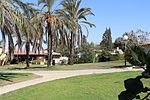The Battle of Shuja'iyya occurred between the Israel Defense Forces and the Izz ad-Din al-Qassam Brigades on 20 July 2014 during 2014 Israel–Gaza conflict in the Shuja'iyya neighborhood of Gaza City, in the Gaza Strip.: 71 Shuja'iyya, with 92,000 people in 6 sq-kilometres, is one of the most densely populated areas of the Gaza Strip. According to the IDF, it had become a "terrorist fortress", that between 8 and 20 July had fired over 140 rockets into Israel after the outbreak of hostilities. Casualty figures are not known with precision, partly because bodies were recovered long after the fighting, and people had also died of injuries afterwards. The UN Protection Cluster states that between the 19-20th, 55 civilians, including 19 children and 14 women, were killed as a result of the IDF's actions. At the time, estimates varied from 66 to about 120 Palestinians killed, with a third of them women and children, and at least 288 wounded. The UN figures of Palestinian casualties are preliminary and subject to revision. 16 Israeli soldiers were killed.On 16 July, Israeli forces told residents of Shuja'iyya to leave and relocate to central Gaza City until further notice by means of leaflets, loudspeaker announcements, telephone calls, text messages, and radio messages. Residents interviewed afterwards by The Independent claimed lack of safe refuges and the difficulty of fleeing as reasons for staying put. By 19 July, OCHA reported that while the majority ignored the warnings and had not left their homes, up to half had gone as bombardments intensified. Israel condemned Hamas for using "human shields". According to Amnesty International, the UNRWA shelter facilities were overflowing and many of the residents had nowhere to go. Residents interviewed later also cited confusion due of lack of electricity and communications. The official Israeli view was that Hamas had compelled residents of Shujai'iya to stay behind in the face of IDF warnings to evacuate prior to the IDF assault, holding civilians as "hostages".The assault on Shuja'iyya, involving a combination of F-16, tank and mortar fire, began at 11 pm on 19 July. Initially the attack led by the Golani Brigade encountered little resistance, until late on Saturday Hamas units emerged from tunnels to engage and put up stiff resistance, surprising the Israelis with their tenacity and effectiveness in taking on armoured units. According to Israeli military and intelligence sources, Israel then made use of heavy aerial bombardment and artillery fire, in what was described as a "risky and unusual step to save Israeli soldiers' lives" and "a battle against the hub of Hamas' terror infrastructure, primarily the so-called 'terror tunnels'". Palestinians attempting to flee the area described the scene as a "massacre", as did Mahmoud Abbas, Richard Falk, Norwegian physician Dr. Mads Gilbert and journalist Sharif Abdel Kouddous in The Nation.
The conclusion of U.S. military experts interviewed by Mark Perry was that the IDF did not target Hamas sites specifically or try solely to destroy Hamas tunnels, but rather laid down a "walking barrage" to "crater the neighbourhood". This bombardment was carried out instead of using suppressive fire to protect IDF forward troops, a strategy they deemed "indefensible". The operation was condemned internationally, with UN Secretary General Ban Ki-Moon calling it an "atrocious action" and the European Union stating that it "is particularly appalled by the human cost of the Israeli military operation in Shuja'iyya", while also criticising Hamas calls for using "human shields".









